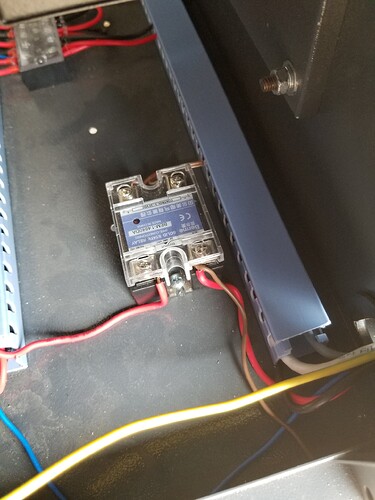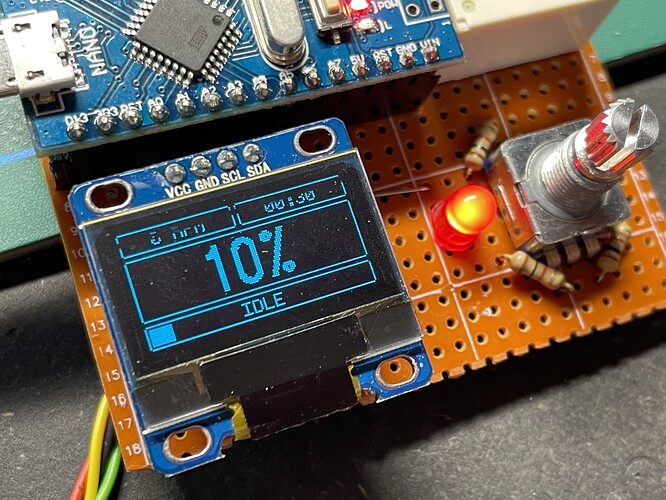For what it’s worth, in the process of doing my homebrew upgrades, I friend my Ruida controller. Don’t recall which ports, but it definitely wasn’t happy about something I wired up. Ended up buying a new controller, etc.
In the off chance it’s a machine setting on the Ruida controller. Here are my settings in case you notice one that might need to be changed…
{
“Name”: “Ruida”,
“Settings”: [
{
“Desc”: “Idle speed (mm/s)”,
“ID”: “0x5”,
“Value”: 300
},
{
“Desc”: “Idle acceleration (mm/s^2)”,
“ID”: “0x20a”,
“Value”: 2000
},
{
“Desc”: “Idle delay (ms)”,
“ID”: “0x203”,
“Value”: 0
},
{
“Desc”: “Start speed (mm/s)”,
“ID”: “0x201”,
“Value”: 7
},
{
“Desc”: “Min acceleration (mm/s^2)”,
“ID”: “0x209”,
“Value”: 400
},
{
“Desc”: “Max acceleration (mm/s^2)”,
“ID”: “0x202”,
“Value”: 2000
},
{
“Desc”: “Accel factor % (0 to 200)”,
“ID”: “0x21a”,
“Value”: 80
},
{
“Desc”: “G0 accel factor % (0 to 200)”,
“ID”: “0x21c”,
“Value”: 120
},
{
“Desc”: “Speed factor % (0 to 200)”,
“ID”: “0x21b”,
“Value”: 80
},
{
“Desc”: “X start speed (mm/sec)”,
“ID”: “0x224”,
“Value”: 20
},
{
“Desc”: “Y start speed (mm/sec)”,
“ID”: “0x234”,
“Value”: 7
},
{
“Desc”: “X acceleration (mm/s^2)”,
“ID”: “0x225”,
“Value”: 3000
},
{
“Desc”: “Y acceleration (mm/s^2)”,
“ID”: “0x235”,
“Value”: 2000
},
{
“Desc”: “Line shift speed (mm/sec)”,
“ID”: “0xe”,
“Value”: 150
},
{
“Desc”: “Facula Size (50 - 99%)”,
“ID”: “0xb”,
“Value”: 98
},
{
“Desc”: “Engraving factor % (0 to 100)”,
“ID”: “0x237”,
“Value”: 100
},
{
“Desc”: “Enable Rotary”,
“ID”: “0x2260001”,
“Value”: false
},
{
“Desc”: “Pulses per rotation”,
“ID”: “0x21f”,
“Value”: 51200
},
{
“Desc”: “Diameter”,
“ID”: “0x221”,
“Value”: 103
},
{
“Desc”: “Focus Distance”,
“ID”: “0x20e”,
“Value”: 0
},
{
“Desc”: “X Axis Backlash (mm)”,
“ID”: “0x2b”,
“Value”: 0
},
{
“Desc”: “Y Axis Backlash (mm)”,
“ID”: “0x3b”,
“Value”: 0
},
{
“Desc”: “Enable wireless panel speed shift”,
“ID”: “0x2260004”,
“Value”: true
},
{
“Desc”: “Wireless panel speed fast (mm/sec)”,
“ID”: “0x231”,
“Value”: 400
},
{
“Desc”: “Wireless panel speed slow (mm/sec)”,
“ID”: “0x232”,
“Value”: 100
},
{
“Desc”: “Engraving Mode”,
“ID”: “0x100400”,
“Value”: “Common Mode”
},
{
“Desc”: “Return Position”,
“ID”: “0x200”,
“Value”: “Origin”
},
{
“Desc”: “Homing Speed (mm/sec)”,
“ID”: “0xc”,
“Value”: 25
},
{
“Desc”: “Laser 1 Output Signal”,
“ID”: “0x40200”,
“Value”: “Low”
},
{
“Desc”: “Laser 2 Output Signal”,
“ID”: “0x40400”,
“Value”: “Low”
},
{
“Desc”: “Water Protect Enable, Laser 1”,
“ID”: “0x40020”,
“Value”: false
},
{
“Desc”: “Water Protect Enable, Laser 2”,
“ID”: “0x40040”,
“Value”: false
},
{
“Desc”: “Enable air-assist output”,
“ID”: “0x40002”,
“Value”: true
},
{
“Desc”: “Enable door open protect”,
“ID”: “0x40001”,
“Value”: false
},
{
“Desc”: “Enable Homing”,
“ID”: “0x200008”,
“Value”: true
},
{
“Desc”: “Limit Trigger”,
“ID”: “0x200006”,
“Value”: false
},
{
“Desc”: “Invert Keypad Direction”,
“ID”: “0x200005”,
“Value”: true
},
{
“Desc”: “PWM Rising Edge Valid”,
“ID”: “0x200004”,
“Value”: false
},
{
“Desc”: “Limiter Polarity”,
“ID”: “0x200003”,
“Value”: false
},
{
“Desc”: “Direction Polarity”,
“ID”: “0x200002”,
“Value”: true
},
{
“Desc”: “Step length (um)”,
“ID”: “0x21”,
“Value”: 4.933
},
{
“Desc”: “Max speed (mm/sec)”,
“ID”: “0x23”,
“Value”: 500
},
{
“Desc”: “Jumpoff speed (mm/s^2)”,
“ID”: “0x24”,
“Value”: 20
},
{
“Desc”: “Max acceleration (mm/s^2)”,
“ID”: “0x25”,
“Value”: 3000
},
{
“Desc”: “Max travel (mm)”,
“ID”: “0x26”,
“Value”: 773
},
{
“Desc”: “Keypad jumpoff speed (mm/sec)”,
“ID”: “0x27”,
“Value”: 15
},
{
“Desc”: “Keypad acceleration (mm/s^2)”,
“ID”: “0x28”,
“Value”: 3000
},
{
“Desc”: “E-Stop acceleration (mm/s^2)”,
“ID”: “0x29”,
“Value”: 30000
},
{
“Desc”: “Home offset (mm)”,
“ID”: “0x2a”,
“Value”: 0
},
{
“Desc”: “Enable Homing”,
“ID”: “0x300008”,
“Value”: true
},
{
“Desc”: “Limit Trigger”,
“ID”: “0x300006”,
“Value”: false
},
{
“Desc”: “Invert Keypad Direction”,
“ID”: “0x300005”,
“Value”: false
},
{
“Desc”: “PWM Rising Edge Valid”,
“ID”: “0x300004”,
“Value”: false
},
{
“Desc”: “Limiter Polarity”,
“ID”: “0x300003”,
“Value”: false
},
{
“Desc”: “Direction Polarity”,
“ID”: “0x300002”,
“Value”: true
},
{
“Desc”: “Step length (um)”,
“ID”: “0x31”,
“Value”: 4.933
},
{
“Desc”: “Max speed (mm/sec)”,
“ID”: “0x33”,
“Value”: 400
},
{
“Desc”: “Jumpoff speed (mm/s^2)”,
“ID”: “0x34”,
“Value”: 7
},
{
“Desc”: “Max acceleration (mm/s^2)”,
“ID”: “0x35”,
“Value”: 3000
},
{
“Desc”: “Max travel (mm)”,
“ID”: “0x36”,
“Value”: 555
},
{
“Desc”: “Keypad jumpoff speed (mm/sec)”,
“ID”: “0x37”,
“Value”: 7
},
{
“Desc”: “Keypad acceleration (mm/s^2)”,
“ID”: “0x38”,
“Value”: 1500
},
{
“Desc”: “E-Stop acceleration (mm/s^2)”,
“ID”: “0x39”,
“Value”: 12000
},
{
“Desc”: “Home offset (mm)”,
“ID”: “0x3a”,
“Value”: 0
},
{
“Desc”: “Enable Homing”,
“ID”: “0x400008”,
“Value”: true
},
{
“Desc”: “Limit Trigger”,
“ID”: “0x400006”,
“Value”: false
},
{
“Desc”: “Invert Keypad Direction”,
“ID”: “0x400005”,
“Value”: true
},
{
“Desc”: “PWM Rising Edge Valid”,
“ID”: “0x400004”,
“Value”: false
},
{
“Desc”: “Limiter Polarity”,
“ID”: “0x400003”,
“Value”: false
},
{
“Desc”: “Direction Polarity”,
“ID”: “0x400002”,
“Value”: true
},
{
“Desc”: “Step length (um)”,
“ID”: “0x41”,
“Value”: 0.067
},
{
“Desc”: “Max speed (mm/sec)”,
“ID”: “0x43”,
“Value”: 2
},
{
“Desc”: “Jumpoff speed (mm/s^2)”,
“ID”: “0x44”,
“Value”: 10
},
{
“Desc”: “Max acceleration (mm/s^2)”,
“ID”: “0x45”,
“Value”: 500
},
{
“Desc”: “Max travel (mm)”,
“ID”: “0x46”,
“Value”: 180
},
{
“Desc”: “Keypad jumpoff speed (mm/sec)”,
“ID”: “0x47”,
“Value”: 1
},
{
“Desc”: “Keypad acceleration (mm/s^2)”,
“ID”: “0x48”,
“Value”: 500
},
{
“Desc”: “E-Stop acceleration (mm/s^2)”,
“ID”: “0x49”,
“Value”: 10000
},
{
“Desc”: “Home offset (mm)”,
“ID”: “0x4a”,
“Value”: 120
},
{
“Desc”: “Enable Homing”,
“ID”: “0x500008”,
“Value”: false
},
{
“Desc”: “Limit Trigger”,
“ID”: “0x500006”,
“Value”: false
},
{
“Desc”: “Invert Keypad Direction”,
“ID”: “0x500005”,
“Value”: true
},
{
“Desc”: “PWM Rising Edge Valid”,
“ID”: “0x500004”,
“Value”: false
},
{
“Desc”: “Limiter Polarity”,
“ID”: “0x500003”,
“Value”: false
},
{
“Desc”: “Direction Polarity”,
“ID”: “0x500002”,
“Value”: true
},
{
“Desc”: “Step length (um)”,
“ID”: “0x51”,
“Value”: 6.337498
},
{
“Desc”: “Max speed (mm/sec)”,
“ID”: “0x53”,
“Value”: 300
},
{
“Desc”: “Jumpoff speed (mm/s^2)”,
“ID”: “0x54”,
“Value”: 15
},
{
“Desc”: “Max acceleration (mm/s^2)”,
“ID”: “0x55”,
“Value”: 5000
},
{
“Desc”: “Max travel (mm)”,
“ID”: “0x56”,
“Value”: 600
},
{
“Desc”: “Keypad jumpoff speed (mm/sec)”,
“ID”: “0x57”,
“Value”: 15
},
{
“Desc”: “Keypad acceleration (mm/s^2)”,
“ID”: “0x58”,
“Value”: 4000
},
{
“Desc”: “E-Stop acceleration (mm/s^2)”,
“ID”: “0x59”,
“Value”: 10000
},
{
“Desc”: “Home offset (mm)”,
“ID”: “0x5a”,
“Value”: 0
},
{
“Desc”: “Tube Type”,
“ID”: “0x100003”,
“Value”: “Glass Tube”
},
{
“Desc”: “Multi-Tube Enable”,
“ID”: “0x108000”,
“Value”: false
},
{
“Desc”: “Laser 1 Enabled”,
“ID”: “0x102000”,
“Value”: true
},
{
“Desc”: “Laser 2 Enabled”,
“ID”: “0x104000”,
“Value”: false
},
{
“Desc”: “Laser 1 minimum power (%)”,
“ID”: “0x12”,
“Value”: 1
},
{
“Desc”: “Laser 1 maximum power (%)”,
“ID”: “0x13”,
“Value”: 99
},
{
“Desc”: “Laser 1 frequency (hz)”,
“ID”: “0x11”,
“Value”: 20000
},
{
“Desc”: “Laser 1 pre-ignition frequency (hz)”,
“ID”: “0x1a”,
“Value”: 5000
},
{
“Desc”: “Laser 1 pre-ignition percent (%)”,
“ID”: “0x1b”,
“Value”: 1
},
{
“Desc”: “Laser 2 minimum power (%)”,
“ID”: “0x18”,
“Value”: 1
},
{
“Desc”: “Laser 2 maximum power (%)”,
“ID”: “0x19”,
“Value”: 99
},
{
“Desc”: “Laser 2 frequency (hz)”,
“ID”: “0x17”,
“Value”: 20000
},
{
“Desc”: “Laser 2 pre-ignition frequency (hz)”,
“ID”: “0x1c”,
“Value”: 5000
},
{
“Desc”: “Laser 2 pre-ignition percent (%)”,
“ID”: “0x1d”,
“Value”: 1
}
]
}






